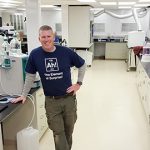
Scientists confirm that slight global warming is GREENING the Antarctic Peninsula with new life, dramatically boosting ecology
Saturday, May 27, 2017 by Amy Goodrich
http://www.healthranger.news/2017-05-27-scientists-confirm-that-slight-global-warming-is-greening-the-antarctic-peninsula-with-new-life-dramatically-boosting-ecology.html

Climate alarmists such as Al Gore have long claimed that climate change is man-made and likely will destroy the world if we don’t curb carbon dioxide (CO2) emissions. Since these statements are based on calculations from computer models, there is no actual evidence that CO2 will harm all life on Earth in any way.
In fact, higher CO2 levels and temperatures are turning the world into a lusher, greener place bursting with new life, according to a team of scientists from the University of Exeter in the United Kingdom. The new study, published in the journal Current Biology, found that over the past 50 years increases in temperature have boosted the growth of moss and microbes in Antarctica.
Since the 1950s, annual temperatures in Antarctica have risen by about half a degree Celsius each decade, which is much faster than the global average. Through the study of core samples taken from 150-year-old moss banks, the researchers were able to get a clear picture of how rising temperatures have affected the ecology of the Peninsula.
Previous research already showed how plants and microbes growing at the southern end of the Antarctic Peninsula underwent unprecedented ecological changes over time. Now, these researchers confirmed that the changes are happening all over the Peninsula. For their follow-up study, the team analyzed five extra samples from three sites, including three Antarctic islands (Elephant Island, Ardley Island, and Green Island). Those different sites house some of the oldest moss banks over a 600-kilometer transect along the Peninsula.
After analyzing the core samples, the team concluded that the Peninsula has undergone fundamental and widespread changes. The data showed increased biological activity as the Peninsula has warmed in the last 50 years. Matt Amesbury, lead author and a researcher at the University of Exeter, said that their data provide a much clearer idea of the scale over which these changes are occurring since previous studies only identified such a response in a single location at the far south of the Antarctic Peninsula.
“What we found were these large, dramatic changes occurring in all of our cores. On average, in terms of the growth rate of moss before and after 1950, there has been a four to five-fold increase in average growth rates” Dr. Amesbury told The Independent.
As the temperature keeps rising, the researchers noted that there is more to come. They expect that the terrestrial ecosystems of the Antarctic Peninsula will continue to experience rapid changes due to global warming.
Dan Charman, who led the research at Exeter, added that the temperature increase has had a significant effect on the growth rates and microbial activity of the Antarctic moss banks. Adding that if this trend continues and the amounts of ice-free land from continued glacier retreat keeps increasing, the Antarctic Peninsula will be a much greener place in the future.
“The results of that analysis lead us to believe there will be a future ‘greening’ of the Antarctic and a further increase in moss growth rates. We are likely to see moss particularly colonizing new areas of ice-free land created by the warmer climate … and particularly things like glacier retreat,” noted the authors of the study.
At the moment, there is about 0.34 percent of the entire Antarctic continent that is predominantly ice-free. Though the Antarctic is clearly showing some significant changes in moss growth and microbiological activity, the researchers noted that the Antarctic will remain an icy place for a long time to come.
Curious to learn more about the Peninsula’s history, the researchers said that they will continue to analyze more cores stretching back thousands of years to explore the impact of climate changes throughout the history of the frozen continent.
For more information about the positive effect of C02 on our planet, check out the video below by Mike Adams, CWC Labs science director and founder of Natural News. He recently released a mini-documentary titled “Why Carbon Dioxide is the ‘Miracle Molecule of Life’ for GREENING our planet.”
Stay informed about changes to our climate at HealthRangerScience.com and ClimateScienceNews.com.
Sources:
Tagged Under: Tags: Antarctic Peninsula, Antarctica, climate change, CO2, CO2 emission, Ecology, global warming





